1976
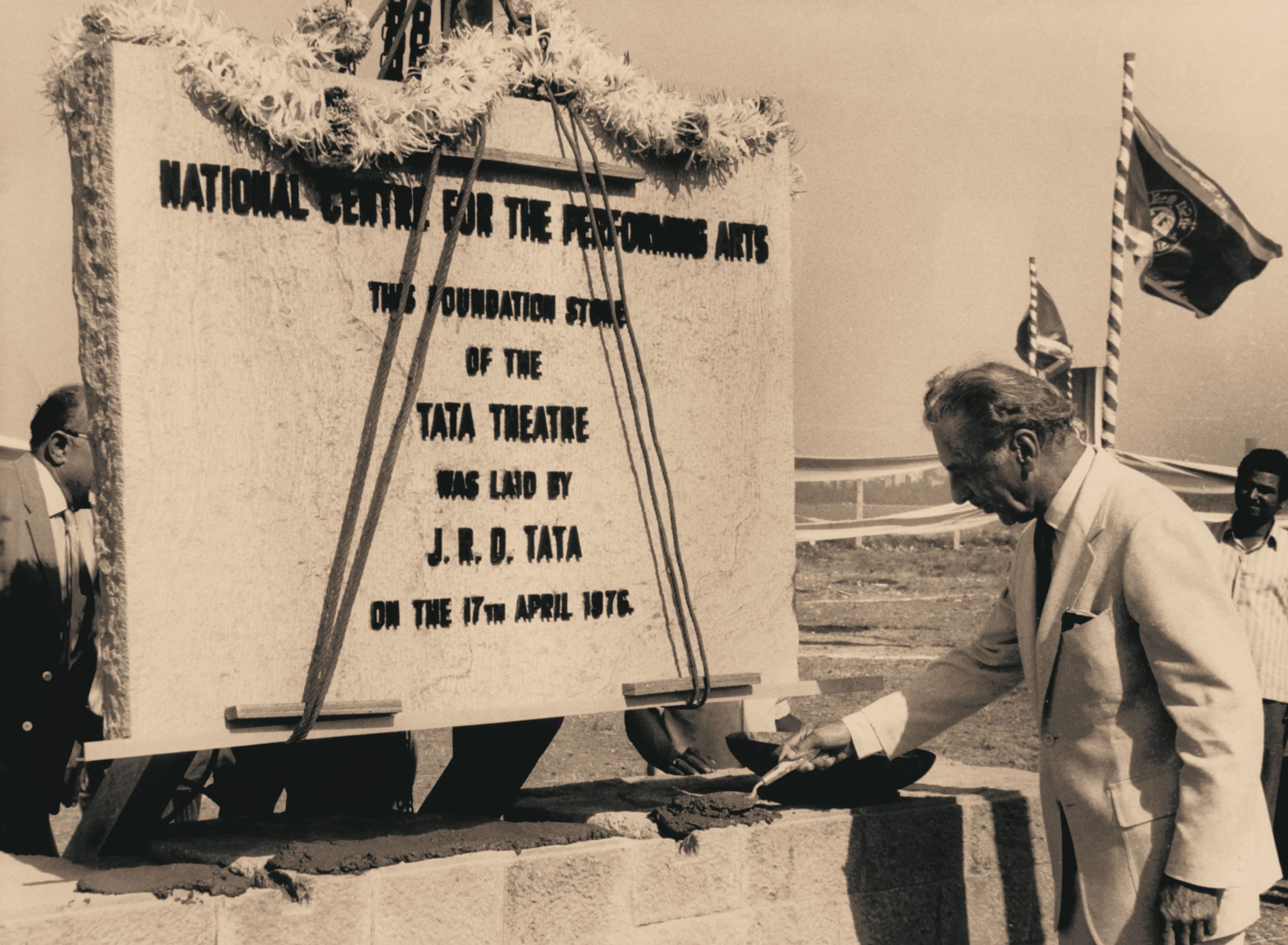
Mr. J.R.D. Tata laid the foundation stone for the Tata Theatre on April 17, 1976. Dr. Jamshed Bhabha’s concept for Tata Theatre was to create a space for the visual and acoustic requirements of Indian music. He visited many concert halls and architectural firms in the West before commissioning one of the world’s great architects, Philip Johnson, to design the auditorium. A similar search for acoustic excellence led Dr. Bhabha to the renowned acoustic consultant, Cyril Harris.

Mr. J.R.D. Tata laid the foundation stone for the Tata Theatre on April 17, 1976. Dr. Jamshed Bhabha’s concept for Tata Theatre was to create a space for the visual and acoustic requirements of Indian music. He visited many concert halls and architectural firms in the West before commissioning one of the world’s great architects, Philip Johnson, to design the auditorium. A similar search for acoustic excellence led Dr. Bhabha to the renowned acoustic consultant, Cyril Harris.
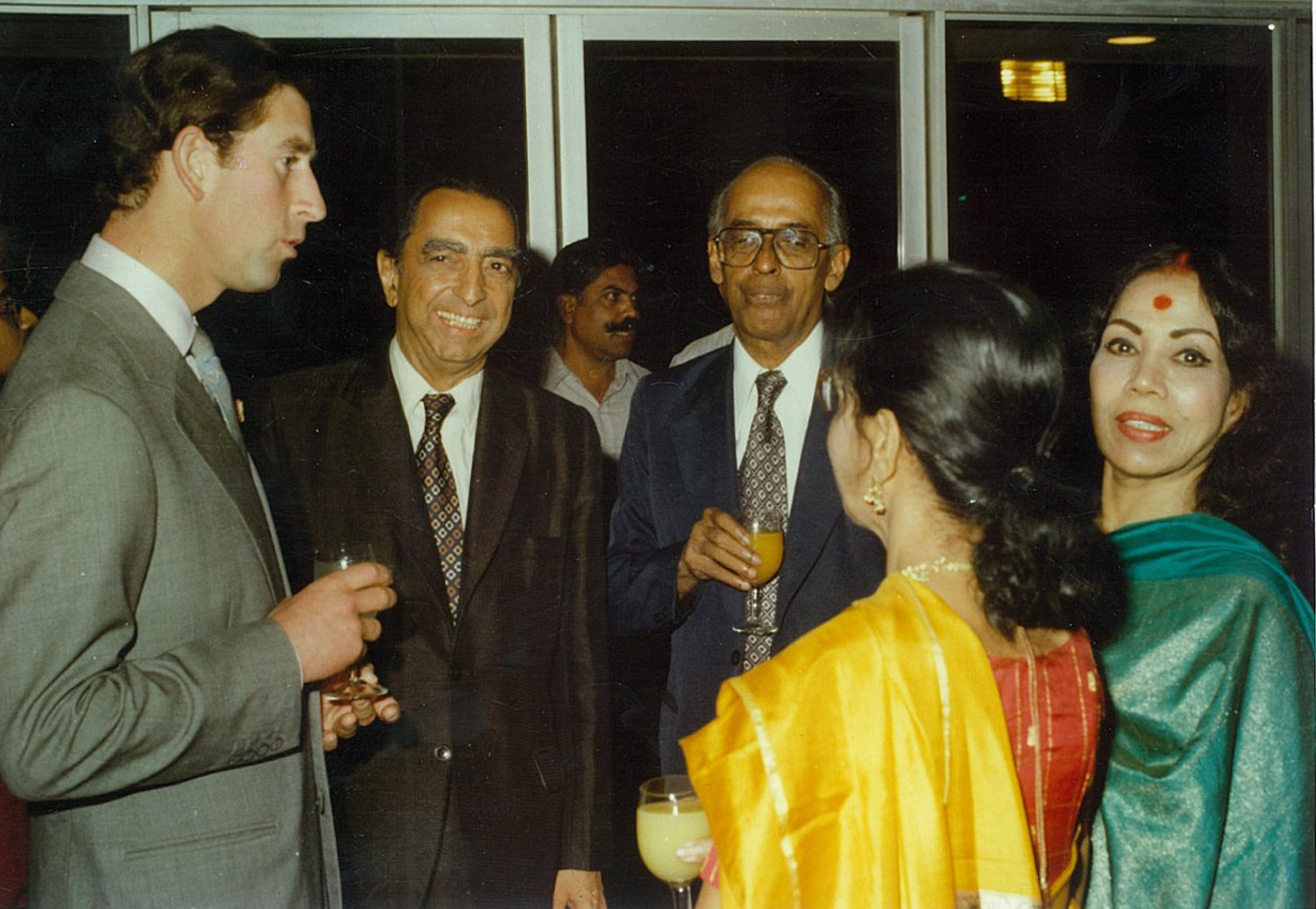
The NCPA has been a venue visited by a number of heads of state, foreign dignitaries and VIPs. Prince Charles visits the NCPA in December 1980.

The NCPA has been a venue visited by a number of heads of state, foreign dignitaries and VIPs. Prince Charles visits the NCPA in December 1980.
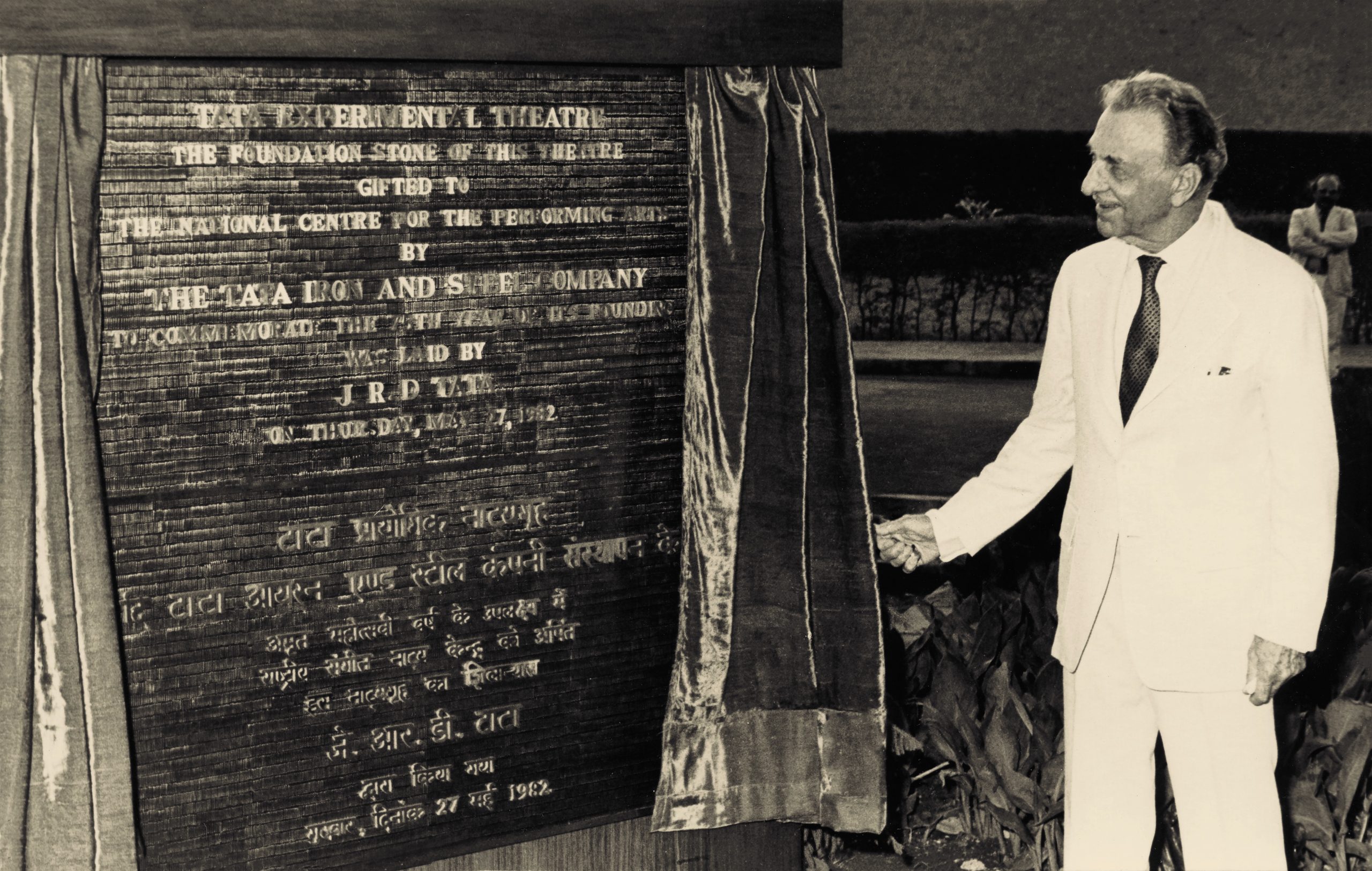
The Tata Iron and Steel Company, in commemoration of its platinum Jubilee, presented the NCPA with the Experimental Theatre, the foundation plaque for which was unveiled by Mr. J.R.D. Tata on 27th May 1982. Based on the principle of the ‘Black Box’ theatre first propagated by Swiss designer Adolphe Appia, which later became popular the world over in the 1970s, this is an unadorned space with black (or dark grey) walls and movable seating modules. The absence of colour gives the audience a sense of ‘any place’, and the lack of décor helps the audience focus on the performance, while giving the director complete flexibility for movement. The NCPA’s Experimental Theatre has been described by many young theatre directors as a critical turning point that shaped the way they looked at theatre craft/métier.

The Tata Iron and Steel Company, in commemoration of its platinum Jubilee, presented the NCPA with the Experimental Theatre, the foundation plaque for which was unveiled by Mr. J.R.D. Tata on 27th May 1982. Based on the principle of the ‘Black Box’ theatre first propagated by Swiss designer Adolphe Appia, which later became popular the world over in the 1970s, this is an unadorned space with black (or dark grey) walls and movable seating modules. The absence of colour gives the audience a sense of ‘any place’, and the lack of décor helps the audience focus on the performance, while giving the director complete flexibility for movement. The NCPA’s Experimental Theatre has been described by many young theatre directors as a critical turning point that shaped the way they looked at theatre craft/métier.
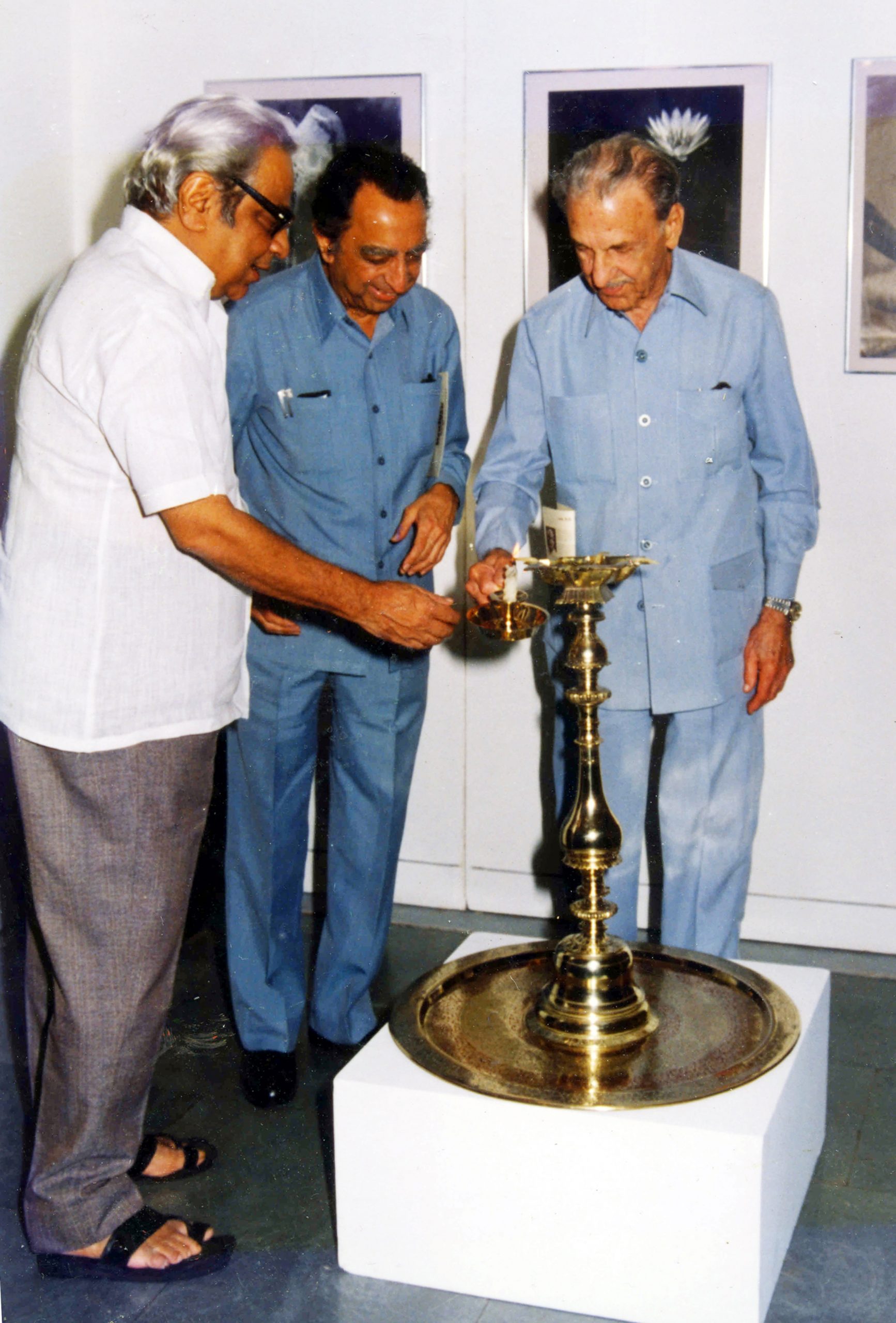
The Centre for Photography as an Art Form, now called The Piramal Gallery, was inaugurated by Mr. J.R.D. Tata, Dr. J.J. Bhabha and Pu La Deshpande in 1987. The NCPA embraces all art forms including the visual medium especially because they are inextricably linked. While most galleries in India focus on the visual arts, this gallery dedicates itself to the art of photography. Since its inception, it has showcased the works of major Indian and international photographers. The Centre is known for promoting art photography as well as for its priceless collection of works of renowned Indian and international photographers.

The Centre for Photography as an Art Form, now called The Piramal Gallery, was inaugurated by Mr. J.R.D. Tata, Dr. J.J. Bhabha and Pu La Deshpande in 1987. The NCPA embraces all art forms including the visual medium especially because they are inextricably linked. While most galleries in India focus on the visual arts, this gallery dedicates itself to the art of photography. Since its inception, it has showcased the works of major Indian and international photographers. The Centre is known for promoting art photography as well as for its priceless collection of works of renowned Indian and international photographers.
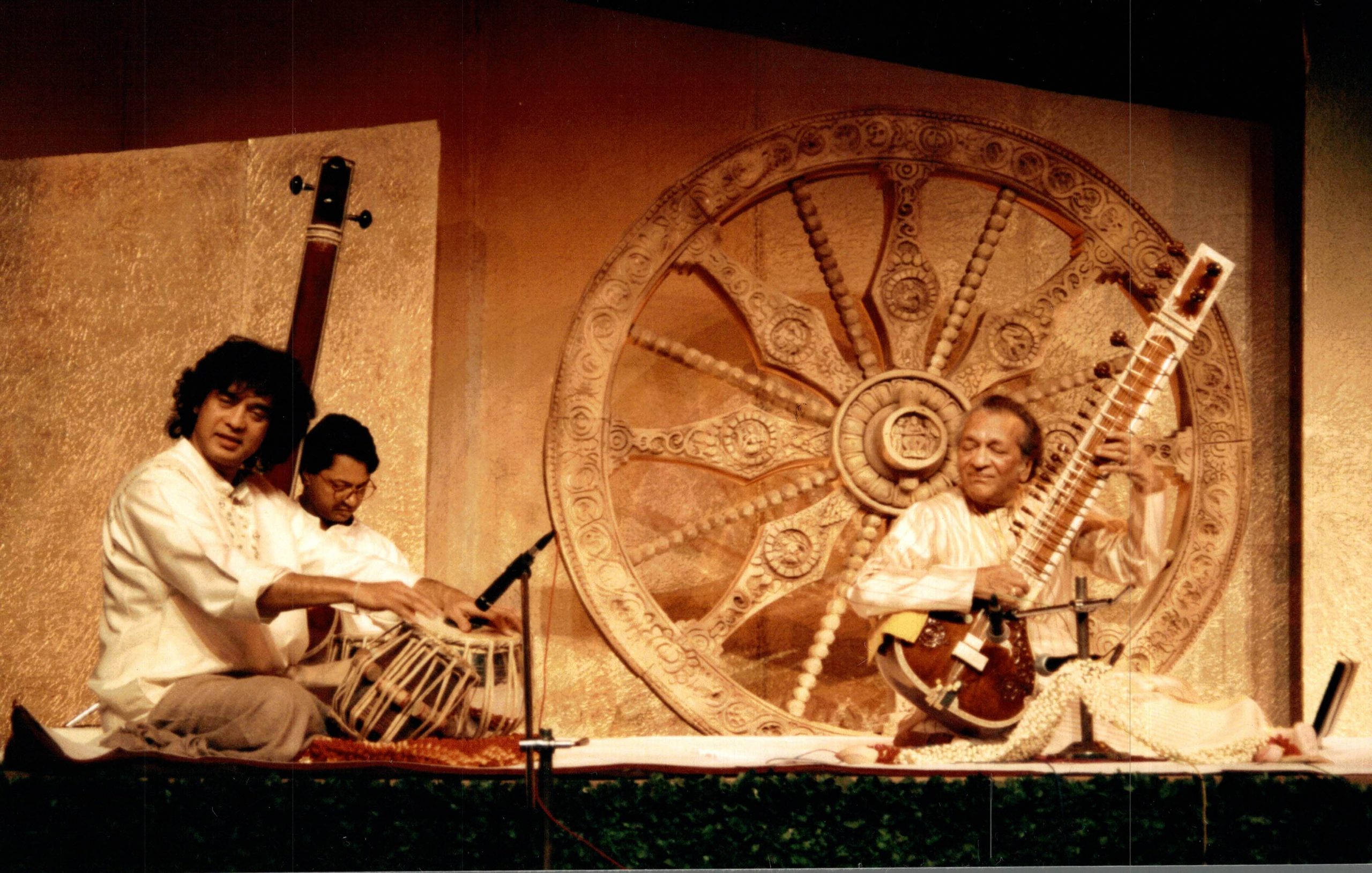
The NCPA held a week-long celebration to mark the 50 years of Indian Independence in August 1997. The landmark event was ushered in by a midnight concert on August 14, 1997 by Ravi Shankar and Zakir Hussain. Several renowned artistes from all genres of performing arts participated in this festival.

The NCPA held a week-long celebration to mark the 50 years of Indian Independence in August 1997. The landmark event was ushered in by a midnight concert on August 14, 1997 by Ravi Shankar and Zakir Hussain. Several renowned artistes from all genres of performing arts participated in this festival.
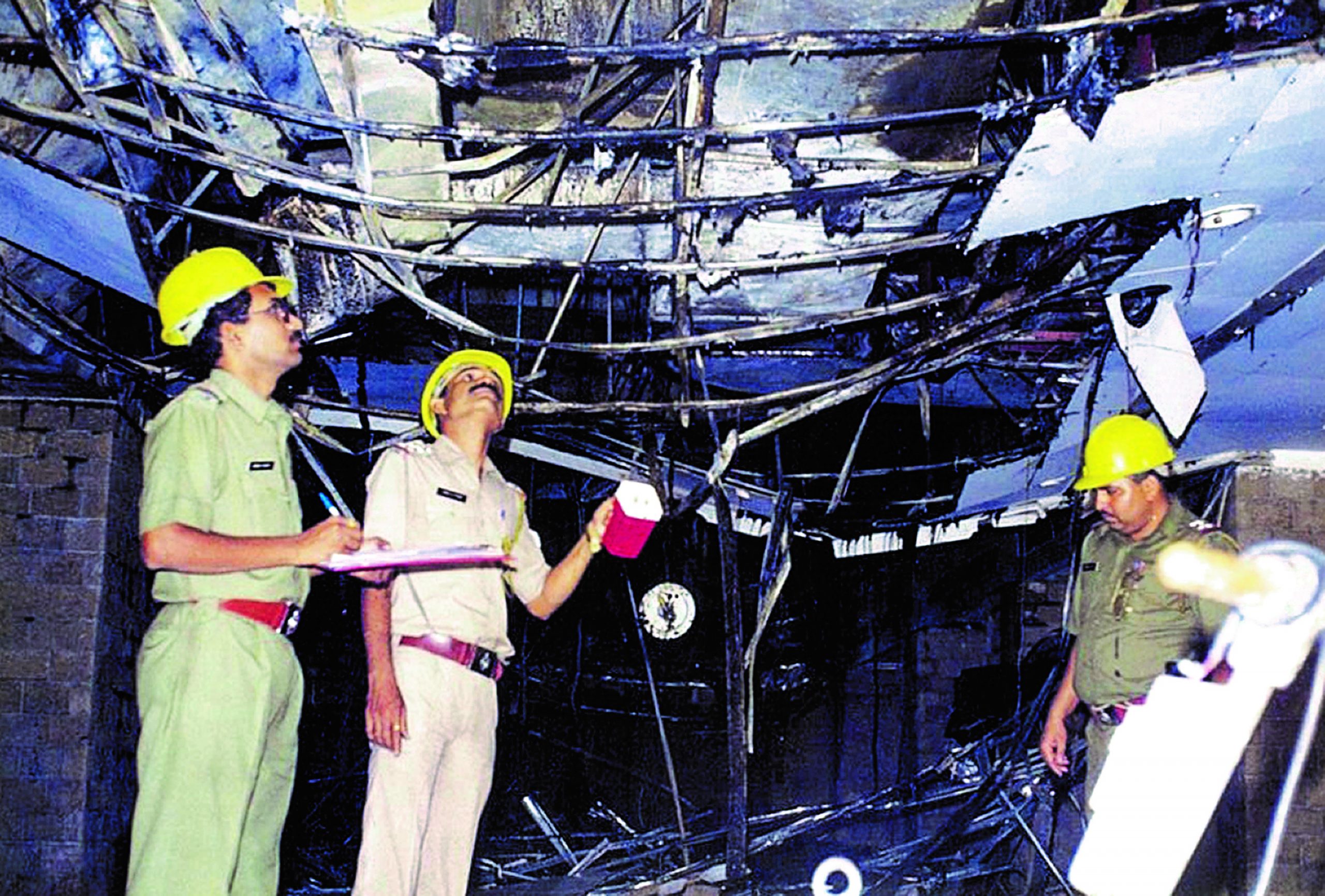
Two months before its completion, in the wee small hours of December 31, 1997, the Jamshed Bhabha Theatre was engulfed by fire. By the morning, the entire almost-complete structure was completely gutted, leaving only rubble and ashes. Dr. Jamshed Bhabha rushed to the spot and watched the tragic and swift destruction of a dream. Even as the horror unfolded before him, he cast despair aside and brought his sense of resilience to the fore. Within minutes he had called a meeting to discuss the future course of action. There were to be no recriminations, no time wasted on an enquiry, all that would be later. He merely said, “Tomorrow, we begin reconstruction”. What he wanted to do was rebuild the theatre brick by brick, inch by inch, and do so as quickly as possible. In less than two years, the Jamshed Bhabha Theatre stood proudly again, ready for its inauguration.

Two months before its completion, in the wee small hours of December 31, 1997, the Jamshed Bhabha Theatre was engulfed by fire. By the morning, the entire almost-complete structure was completely gutted, leaving only rubble and ashes. Dr. Jamshed Bhabha rushed to the spot and watched the tragic and swift destruction of a dream. Even as the horror unfolded before him, he cast despair aside and brought his sense of resilience to the fore. Within minutes he had called a meeting to discuss the future course of action. There were to be no recriminations, no time wasted on an enquiry, all that would be later. He merely said, “Tomorrow, we begin reconstruction”. What he wanted to do was rebuild the theatre brick by brick, inch by inch, and do so as quickly as possible. In less than two years, the Jamshed Bhabha Theatre stood proudly again, ready for its inauguration.
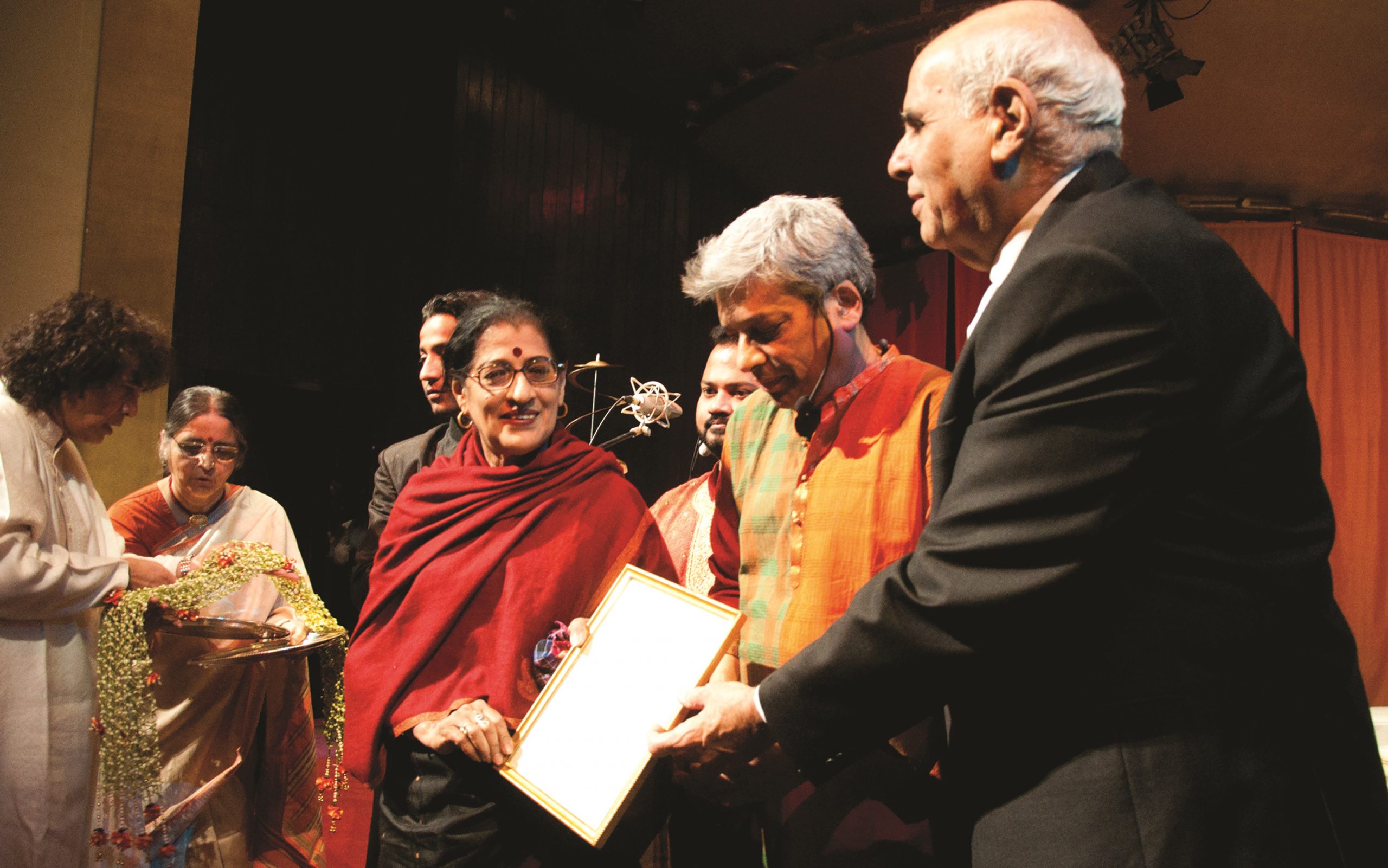
Khushroo N. Suntook conferring the ‘NCPA Lifetime Achievement Award’ upon Padma Vibhushan Kishori Amonkar on January 7, 2011, in the presence of Zakir Hussain, Dr. Suvarnalata Rao (Programming Head for Indian Music at NCPA), Sabir Khan, Selva Ganesh and Trilok Gurtu at the Tata Theatre.

Khushroo N. Suntook conferring the ‘NCPA Lifetime Achievement Award’ upon Padma Vibhushan Kishori Amonkar on January 7, 2011, in the presence of Zakir Hussain, Dr. Suvarnalata Rao (Programming Head for Indian Music at NCPA), Sabir Khan, Selva Ganesh and Trilok Gurtu at the Tata Theatre.

The golden jubilee celebration of the NCPA, held across three days in November and December 2019, was a microcosm of all that the organisation stands for. The multi-genre ADD ART Festival brought together the crème de la crème of art and culture including performances by Arturo Sandoval, Zakir Hussain, Shiv Kumar Sharma, Hariprasad Chaurasia, Birju Maharaj, Aditi Mangaldas, the Symphony Orchestra of India, Jim Sarbh and many more. The joy of experiencing the arts live was extended to audiences beyond the theatres and concert halls, for performers showcased their talent in the myriad open spaces at the NCPA, as enthusiasts soaked in the cultural vibe while enjoying an array of culinary offerings. Adding art to people’s lives drove the 50th-year celebrations, and the city responded with all its love.

The golden jubilee celebration of the NCPA, held across three days in November and December 2019, was a microcosm of all that the organisation stands for. The multi-genre ADD ART Festival brought together the crème de la crème of art and culture including performances by Arturo Sandoval, Zakir Hussain, Shiv Kumar Sharma, Hariprasad Chaurasia, Birju Maharaj, Aditi Mangaldas, the Symphony Orchestra of India, Jim Sarbh and many more. The joy of experiencing the arts live was extended to audiences beyond the theatres and concert halls, for performers showcased their talent in the myriad open spaces at the NCPA, as enthusiasts soaked in the cultural vibe while enjoying an array of culinary offerings. Adding art to people’s lives drove the 50th-year celebrations, and the city responded with all its love.
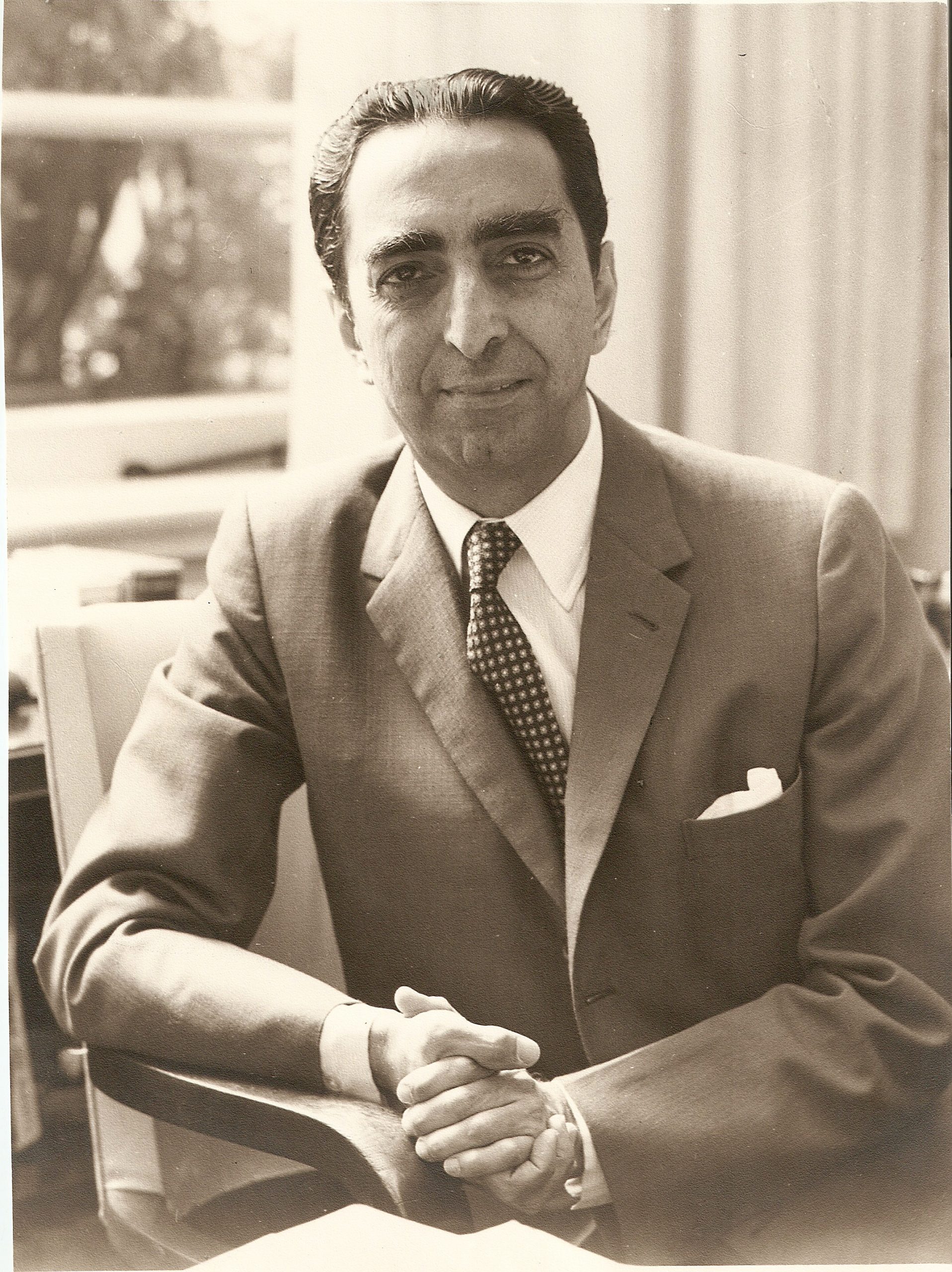
It began, as most great things do, with a dream. It was a dream dreamed by few and pursued by even fewer – that of establishing a definitive arts and culture centre in the country. But the strength of this dream gave it wings, propelled solely by the resolute mind behind it, that of Dr. Jamshed Jehangir Bhabha. Dr. Bhabha keenly felt the lacuna of a pioneering institution to promote and safeguard India’s performing arts tradition. “In India, more perhaps than in any other country, music and related arts constituted a most important part of the country’s 5,000-year-old cultural and spiritual legacy. Music accompanied an Indian from the cradle to the grave; from birth to death,” he wrote in a letter in 1965 to the Dorabji Tata Trust. Despite initial hurdles, the project came to fruition with the full support of J.R.D. Tata and Professor Rustum Choksi, who convinced the Dorabji Tata Trust to make an endowment of Rs 40 lakh towards building the National Centre for the Performing Arts.

It began, as most great things do, with a dream. It was a dream dreamed by few and pursued by even fewer – that of establishing a definitive arts and culture centre in the country. But the strength of this dream gave it wings, propelled solely by the resolute mind behind it, that of Dr. Jamshed Jehangir Bhabha. Dr. Bhabha keenly felt the lacuna of a pioneering institution to promote and safeguard India’s performing arts tradition. “In India, more perhaps than in any other country, music and related arts constituted a most important part of the country’s 5,000-year-old cultural and spiritual legacy. Music accompanied an Indian from the cradle to the grave; from birth to death,” he wrote in a letter in 1965 to the Dorabji Tata Trust. Despite initial hurdles, the project came to fruition with the full support of J.R.D. Tata and Professor Rustum Choksi, who convinced the Dorabji Tata Trust to make an endowment of Rs 40 lakh towards building the National Centre for the Performing Arts.
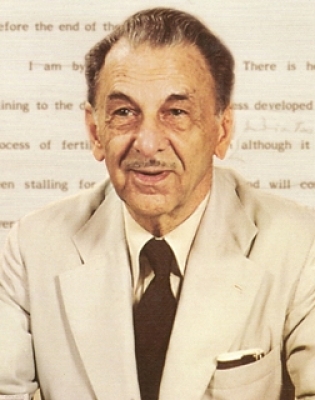
“To innovate, to break new ground, to venture on a path not trodden before, is always a difficult and challenging task anywhere, but particularly in a developing country like India with a vast and growing population and heavy demands on its resources to meet the people’s needs.”
– J.R.D. Tata

“To innovate, to break new ground, to venture on a path not trodden before, is always a difficult and challenging task anywhere, but particularly in a developing country like India with a vast and growing population and heavy demands on its resources to meet the people’s needs.”
– J.R.D. Tata
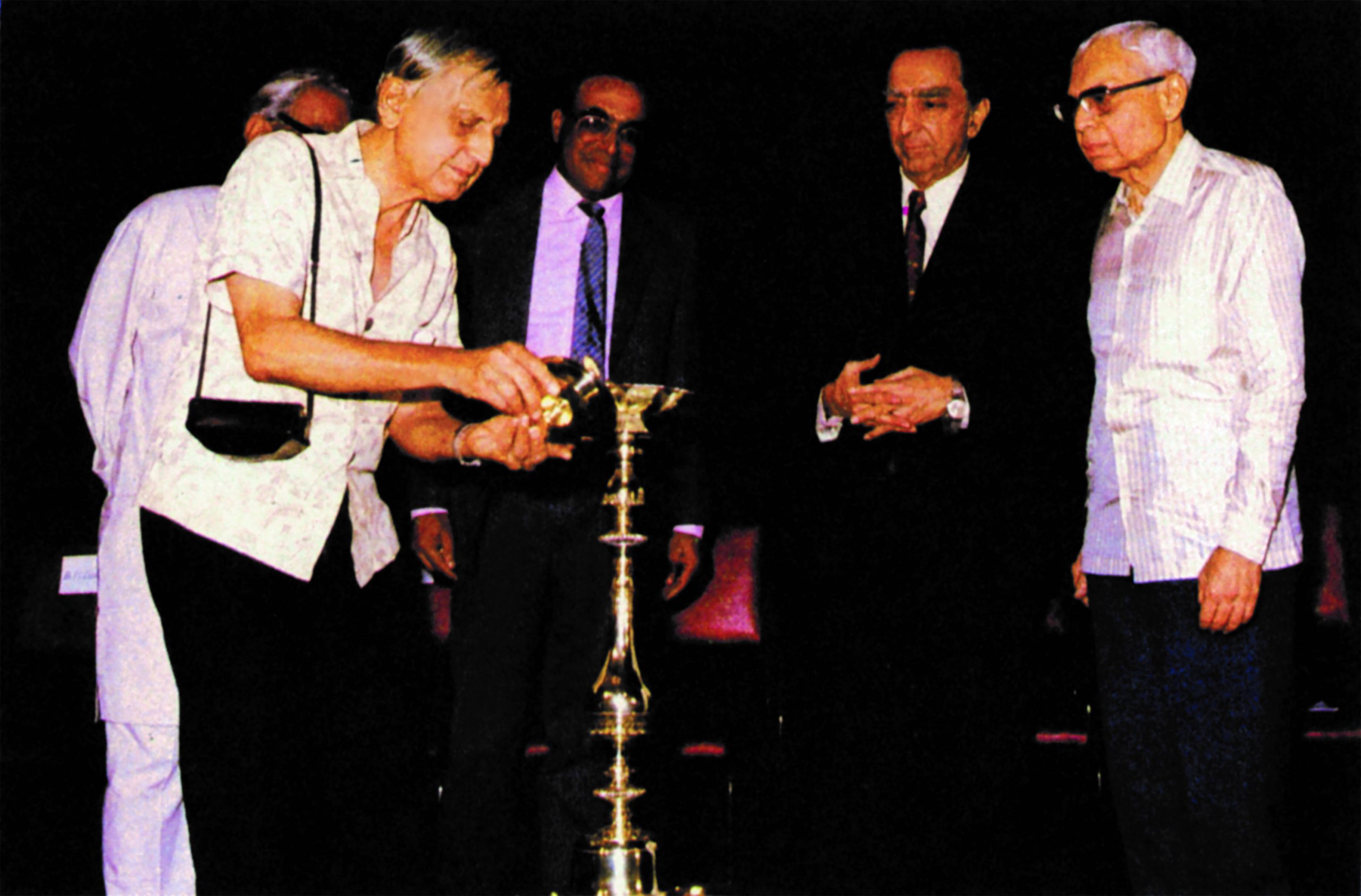
The Godrej Dance Academy, like similar facilities at the outset, was started in the NCPA’s Teaching and Research Block. It was here that many outstanding masterclasses were conducted under eminent gurus like Mohanrao Kallianpurkar and Kelucharan Mohapatra. The Godrej Dance Theatre was constructed in 1987 and over the decades, has witnessed numerous dance performances and lecture-demonstrations by acclaimed artistes. The theatre is also the venue for an array of screenings including ballet (in collaboration with the Bolshoi Theatre and Pathé Live), opera (The Metropolitan Opera), theatre (National Theatre) and film (The Indian Express Film Club).

The Godrej Dance Academy, like similar facilities at the outset, was started in the NCPA’s Teaching and Research Block. It was here that many outstanding masterclasses were conducted under eminent gurus like Mohanrao Kallianpurkar and Kelucharan Mohapatra. The Godrej Dance Theatre was constructed in 1987 and over the decades, has witnessed numerous dance performances and lecture-demonstrations by acclaimed artistes. The theatre is also the venue for an array of screenings including ballet (in collaboration with the Bolshoi Theatre and Pathé Live), opera (The Metropolitan Opera), theatre (National Theatre) and film (The Indian Express Film Club).
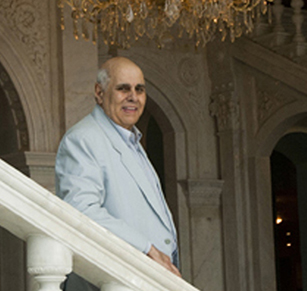
Dr. Bhabha’s motto in life was “When the cause is good, the means will follow”. The creation of India’s National Centre for the Performing Arts at Nariman Point in Mumbai is a tangible example of this belief. Dr Jamshed Bhabha passed away on 30th May 2007. He has been ably succeeded as Chairman of the NCPA by Mr. Khushroo N. Suntook, who carries forward the vision and legacy of the Centre’s founding father, with a view to creating an international arts centre for India fit for audiences in the 21st century

Dr. Bhabha’s motto in life was “When the cause is good, the means will follow”. The creation of India’s National Centre for the Performing Arts at Nariman Point in Mumbai is a tangible example of this belief. Dr Jamshed Bhabha passed away on 30th May 2007. He has been ably succeeded as Chairman of the NCPA by Mr. Khushroo N. Suntook, who carries forward the vision and legacy of the Centre’s founding father, with a view to creating an international arts centre for India fit for audiences in the 21st century
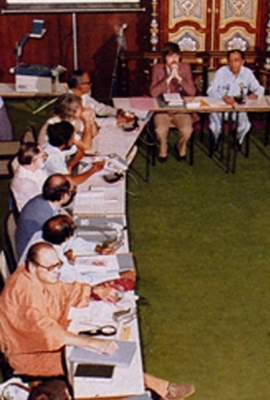
The NCPA initiated a series of East-West Encounters involving composers who were invited to participate in an inquiry into the possibilities of creative work, drawing from both Indian and Western sources. The project involved seminars and workshops spanning the fields of music, philosophy, dance, visual arts and drama between 1983 and 1986.

The NCPA initiated a series of East-West Encounters involving composers who were invited to participate in an inquiry into the possibilities of creative work, drawing from both Indian and Western sources. The project involved seminars and workshops spanning the fields of music, philosophy, dance, visual arts and drama between 1983 and 1986.

The Rodin Exhibition was hosted by the NCPA in the foyers of its Tata Theatre, in collaboration with the French Embassy and Musée Rodin, Paris, in March and April 1983. About 100 bronzes, some of which were six feet high and weighed more than a tonne each, were on display during the exhibition.

The Rodin Exhibition was hosted by the NCPA in the foyers of its Tata Theatre, in collaboration with the French Embassy and Musée Rodin, Paris, in March and April 1983. About 100 bronzes, some of which were six feet high and weighed more than a tonne each, were on display during the exhibition.
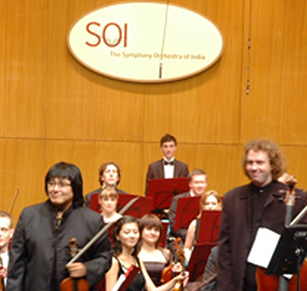
In August 2006, the NCPA formed the Symphony Orchestra of India (SOI), the country’s first fully professional symphony orchestra, offering two seasons in Mumbai each year, in September and in February. The SOI was founded by the NCPA Chairman, Khushroo N. Suntook, and international virtuoso violinist, Marat Bisengaliev, who serves as the orchestra’s Music Director.

In August 2006, the NCPA formed the Symphony Orchestra of India (SOI), the country’s first fully professional symphony orchestra, offering two seasons in Mumbai each year, in September and in February. The SOI was founded by the NCPA Chairman, Khushroo N. Suntook, and international virtuoso violinist, Marat Bisengaliev, who serves as the orchestra’s Music Director.
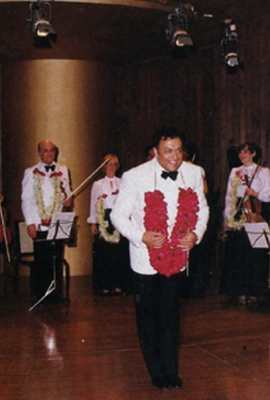
During the 1970s, the NCPA saw many esteemed international performances, including The German Touring Opera Company, Berlin (1971), Music Group of London (1972), Radio Symphony Orchestra of Berlin (1973), German Opera Ballet (1973), Stockholm Marionette Theatre (1975), The Royal Shakespeare Company (1976), Sydney Conservatorium Chamber Orchestra, Stuttgart Trio (1978) and the Sydney String Quartet (1978).

During the 1970s, the NCPA saw many esteemed international performances, including The German Touring Opera Company, Berlin (1971), Music Group of London (1972), Radio Symphony Orchestra of Berlin (1973), German Opera Ballet (1973), Stockholm Marionette Theatre (1975), The Royal Shakespeare Company (1976), Sydney Conservatorium Chamber Orchestra, Stuttgart Trio (1978) and the Sydney String Quartet (1978).
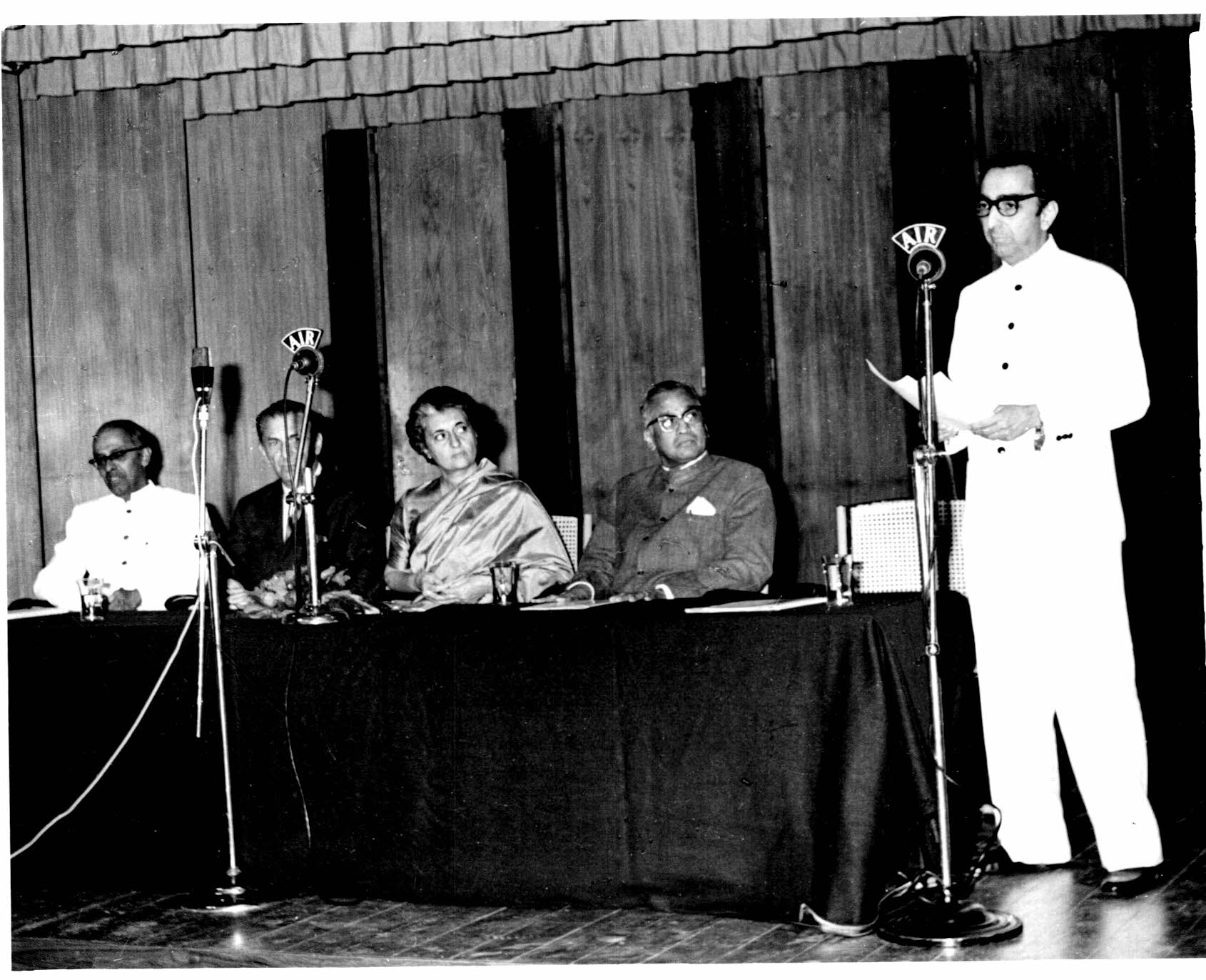
While the reclamation work was on, Dr. Bhabha did not want to let that delay the task of preserving India’s cultural heritage and set up the NCPA in temporary accommodation on the premises of the Bhulabhai Desai Memorial at Akash Ganga in Breach Candy in South Mumbai, generously made available by its Trustee, Madhuri Desai. A recording studio and a 100-seater auditorium with state-of-the-art acoustics and lighting was built in this temporary accommodation.
The inauguration of the studio, auditorium and library in the Centre’s temporary home on Bhulabhai Desai Road by the then Prime Minister, Smt. Indira Gandhi, took place on December 29, 1969 and was followed by a week-long festival featuring P.L. Deshpande, Yamini Krishnamurti and Pandit Ravi Shankar.

While the reclamation work was on, Dr. Bhabha did not want to let that delay the task of preserving India’s cultural heritage and set up the NCPA in temporary accommodation on the premises of the Bhulabhai Desai Memorial at Akash Ganga in Breach Candy in South Mumbai, generously made available by its Trustee, Madhuri Desai. A recording studio and a 100-seater auditorium with state-of-the-art acoustics and lighting was built in this temporary accommodation.
The inauguration of the studio, auditorium and library in the Centre’s temporary home on Bhulabhai Desai Road by the then Prime Minister, Smt. Indira Gandhi, took place on December 29, 1969 and was followed by a week-long festival featuring P.L. Deshpande, Yamini Krishnamurti and Pandit Ravi Shankar.
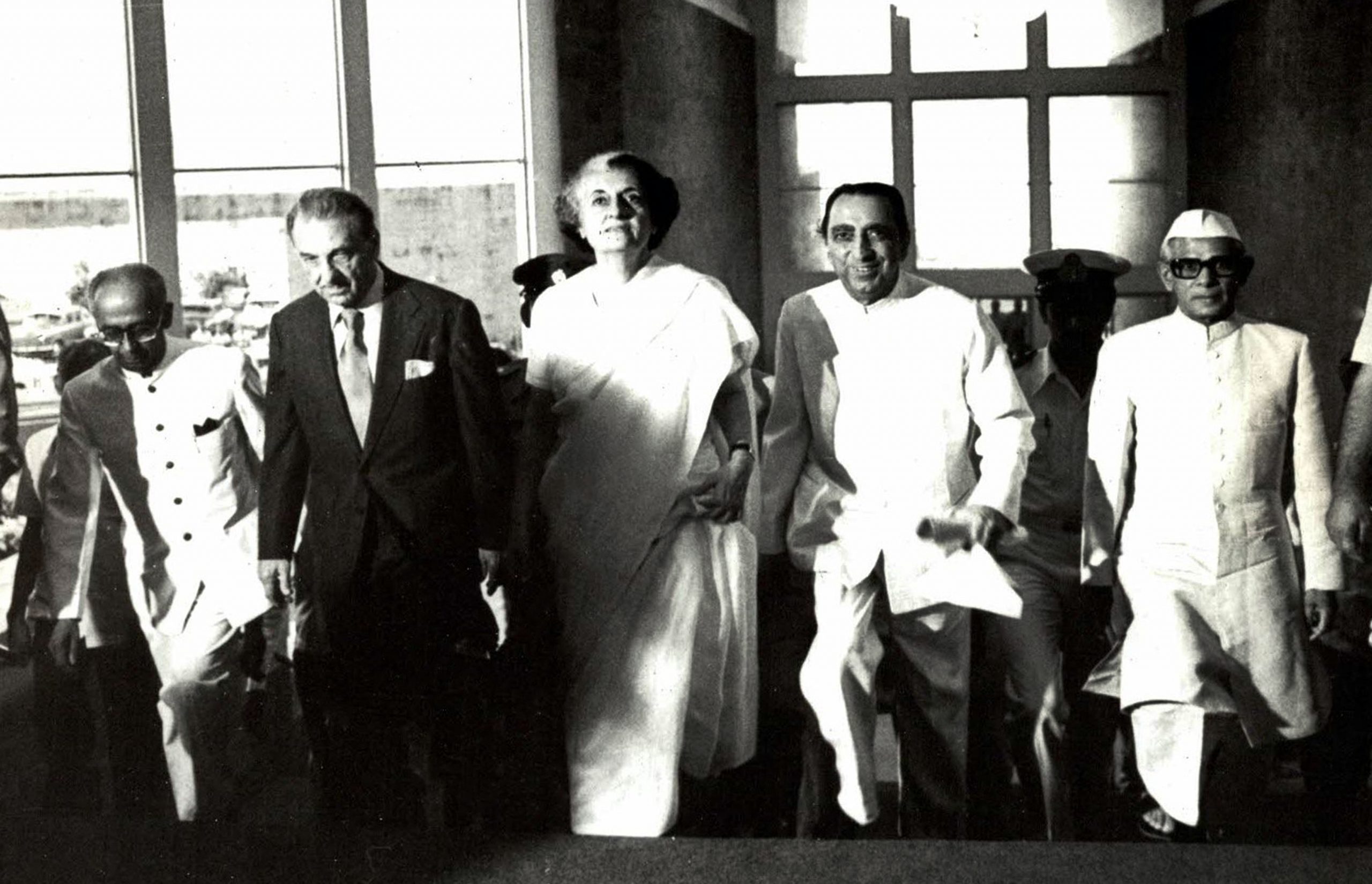
The Tata Theatre was formally inaugurated by Indira Gandhi, the then Prime Minister of India, on October 11, 1980.
Other dignitaries present on the occasion were Dr. V.K. Narayana Menon, Executive Director of the NCPA, Mr. Sadiq Ali, the then Governor of Maharashtra, Mr. A.R. Antulay, the then Chief Minister, Dr. Jamshed Bhabha, Vice-Chairman of the NCPA and Mr. J.R.D. Tata, the Chairman of the Centre. In her inaugural address, the Prime Minister affirmed that the Centre could be a valuable catalyst for creativity and a meaningful bridge between tradition and modernity.

The Tata Theatre was formally inaugurated by Indira Gandhi, the then Prime Minister of India, on October 11, 1980.
Other dignitaries present on the occasion were Dr. V.K. Narayana Menon, Executive Director of the NCPA, Mr. Sadiq Ali, the then Governor of Maharashtra, Mr. A.R. Antulay, the then Chief Minister, Dr. Jamshed Bhabha, Vice-Chairman of the NCPA and Mr. J.R.D. Tata, the Chairman of the Centre. In her inaugural address, the Prime Minister affirmed that the Centre could be a valuable catalyst for creativity and a meaningful bridge between tradition and modernity.
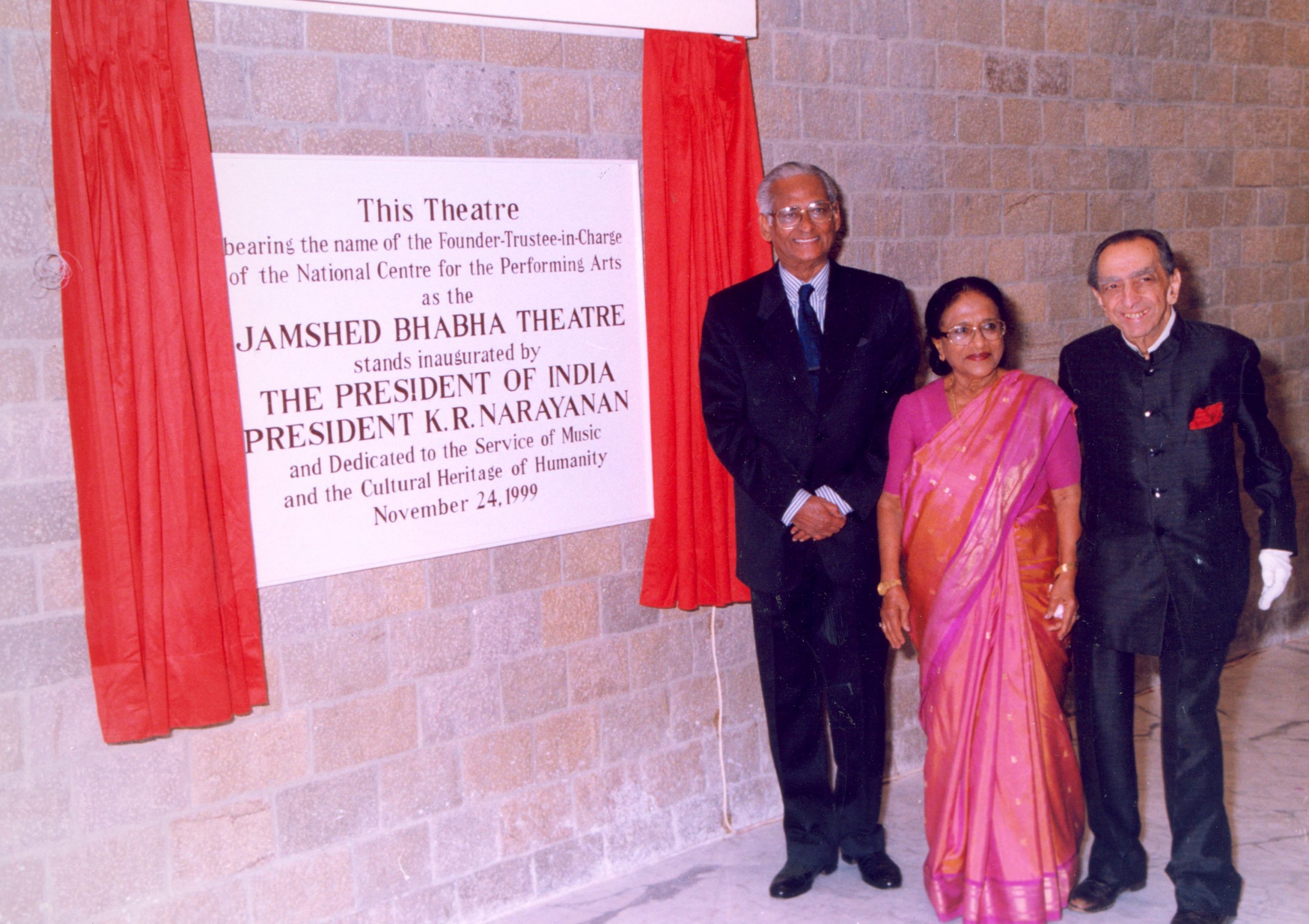
The Jamshed Bhabha Theatre was inaugurated on November 24, 1999. President KR Narayanan was unable to attend the inauguration due to ill health. The Governor of Maharashtra Mr. P.C. Alexander graced the occasion on his behalf instead and unveiled the inauguration plaque. Dr. Jamshed Bhabha wanted to call it the National Theatre, but was prevailed upon by Khushroo N. Suntook, then Vice Chairman and Executive Director of the NCPA, to call it the Jamshed Bhabha Theatre, in fitting tribute to Dr. Bhabha’s leadership and vision.

The Jamshed Bhabha Theatre was inaugurated on November 24, 1999. President KR Narayanan was unable to attend the inauguration due to ill health. The Governor of Maharashtra Mr. P.C. Alexander graced the occasion on his behalf instead and unveiled the inauguration plaque. Dr. Jamshed Bhabha wanted to call it the National Theatre, but was prevailed upon by Khushroo N. Suntook, then Vice Chairman and Executive Director of the NCPA, to call it the Jamshed Bhabha Theatre, in fitting tribute to Dr. Bhabha’s leadership and vision.

In April 1981, British Prime Minister Margaret Thatcher visited the Tata Theatre to see a Kathakali programme presented by the Kerala Kalamandalam troupe.

In April 1981, British Prime Minister Margaret Thatcher visited the Tata Theatre to see a Kathakali programme presented by the Kerala Kalamandalam troupe.
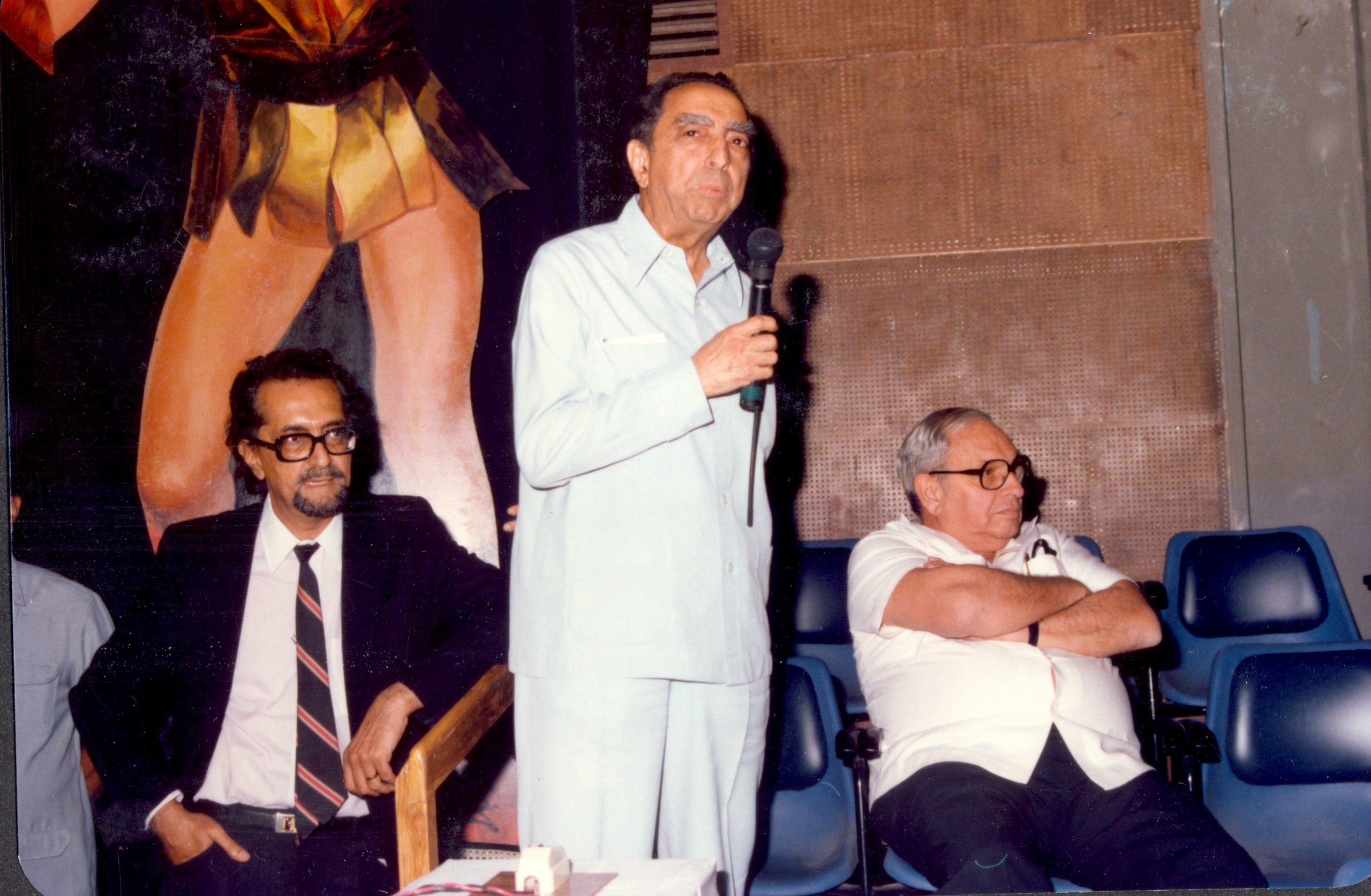
The theatre was inaugurated by Russi Mody, Chairman of TISCO (now Tata Steel) on 26th April, 1986. Tarantula Tanzy, directed by Alyque Padamsee, was staged at the inauguration. The play was set in a boxing ring created in the centre of the auditorium, with the spectators sitting all around to give the feel of a boxing match.

The theatre was inaugurated by Russi Mody, Chairman of TISCO (now Tata Steel) on 26th April, 1986. Tarantula Tanzy, directed by Alyque Padamsee, was staged at the inauguration. The play was set in a boxing ring created in the centre of the auditorium, with the spectators sitting all around to give the feel of a boxing match.
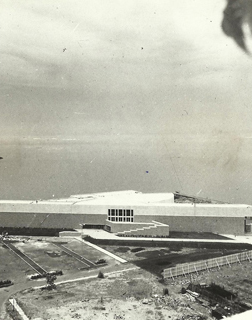
“The art has been handed down by oral tradition and kept alive for centuries by teachers and masters…This category of hereditary teachers is fast drying out and disappearing… Thus, the proposed National Centre for the Performing Arts is necessary for the survival and preservation of a great heritage of music, dance and drama.”
– Jamshed J. BhabhaWhen land in the city was not forthcoming, Dr. Bhabha made an audacious request to the Government of Maharashtra to reclaim a part of the sea at the end of the Marine Drive. The reclamation took over four years to ensure that the land would settle adequately to hold the foundation of these state-of-the-art structures.

“The art has been handed down by oral tradition and kept alive for centuries by teachers and masters…This category of hereditary teachers is fast drying out and disappearing… Thus, the proposed National Centre for the Performing Arts is necessary for the survival and preservation of a great heritage of music, dance and drama.”
– Jamshed J. BhabhaWhen land in the city was not forthcoming, Dr. Bhabha made an audacious request to the Government of Maharashtra to reclaim a part of the sea at the end of the Marine Drive. The reclamation took over four years to ensure that the land would settle adequately to hold the foundation of these state-of-the-art structures.
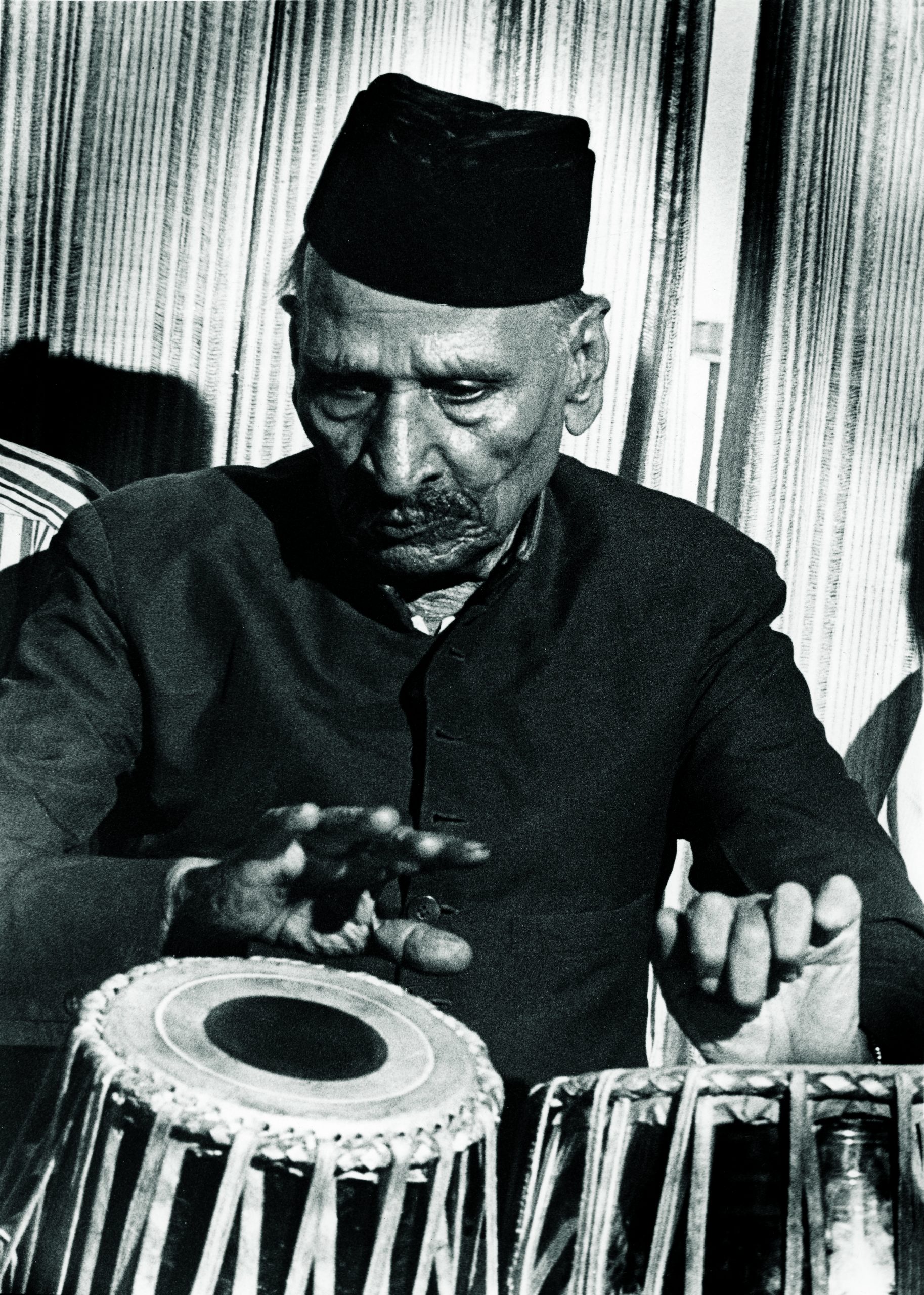
Viewing it as an urgent task, the NCPA recorded the great exponents of Indian classical music for its Archives, thereby saving it for posterity. Between 1969 and 1974, most of the leading exponents of the Hindustani and Carnatic traditions were recorded.
The Centre’s first recording was with tabla maestro Ahmed Jan Thirakwa. Already in his 80s, the maestro played an exquisite tabla solo and also answered questions from Nikhil Ghosh about his gharana, all of which was recorded. The archives feature rare renditions by doyens of Hindustani and Carnatic music, specially curated by the NCPA and recorded at the NCPA recording studio. These include recordings of Gangubai Hangal, Kumar Gandharva, Mallikarjun Mansur, Siddheshwari Devi, Hariprasad Chaurasia, Amjad Ali Khan, Lalgudi Jayaraman, Bismillah Khan, Jasraj Dagar brothers, M. S. Subbulakshmi, D. K. Pattamal, M. L. Vasanthakumari, T. R. Mahalingam, Semmangudi Srinivasa Iyer, Ali Akbar Khan, Vilayat Khan, Alla Rakha, Begum Akhtar, Dr. Balamuralikrishna to name a few.

Viewing it as an urgent task, the NCPA recorded the great exponents of Indian classical music for its Archives, thereby saving it for posterity. Between 1969 and 1974, most of the leading exponents of the Hindustani and Carnatic traditions were recorded.
The Centre’s first recording was with tabla maestro Ahmed Jan Thirakwa. Already in his 80s, the maestro played an exquisite tabla solo and also answered questions from Nikhil Ghosh about his gharana, all of which was recorded. The archives feature rare renditions by doyens of Hindustani and Carnatic music, specially curated by the NCPA and recorded at the NCPA recording studio. These include recordings of Gangubai Hangal, Kumar Gandharva, Mallikarjun Mansur, Siddheshwari Devi, Hariprasad Chaurasia, Amjad Ali Khan, Lalgudi Jayaraman, Bismillah Khan, Jasraj Dagar brothers, M. S. Subbulakshmi, D. K. Pattamal, M. L. Vasanthakumari, T. R. Mahalingam, Semmangudi Srinivasa Iyer, Ali Akbar Khan, Vilayat Khan, Alla Rakha, Begum Akhtar, Dr. Balamuralikrishna to name a few.
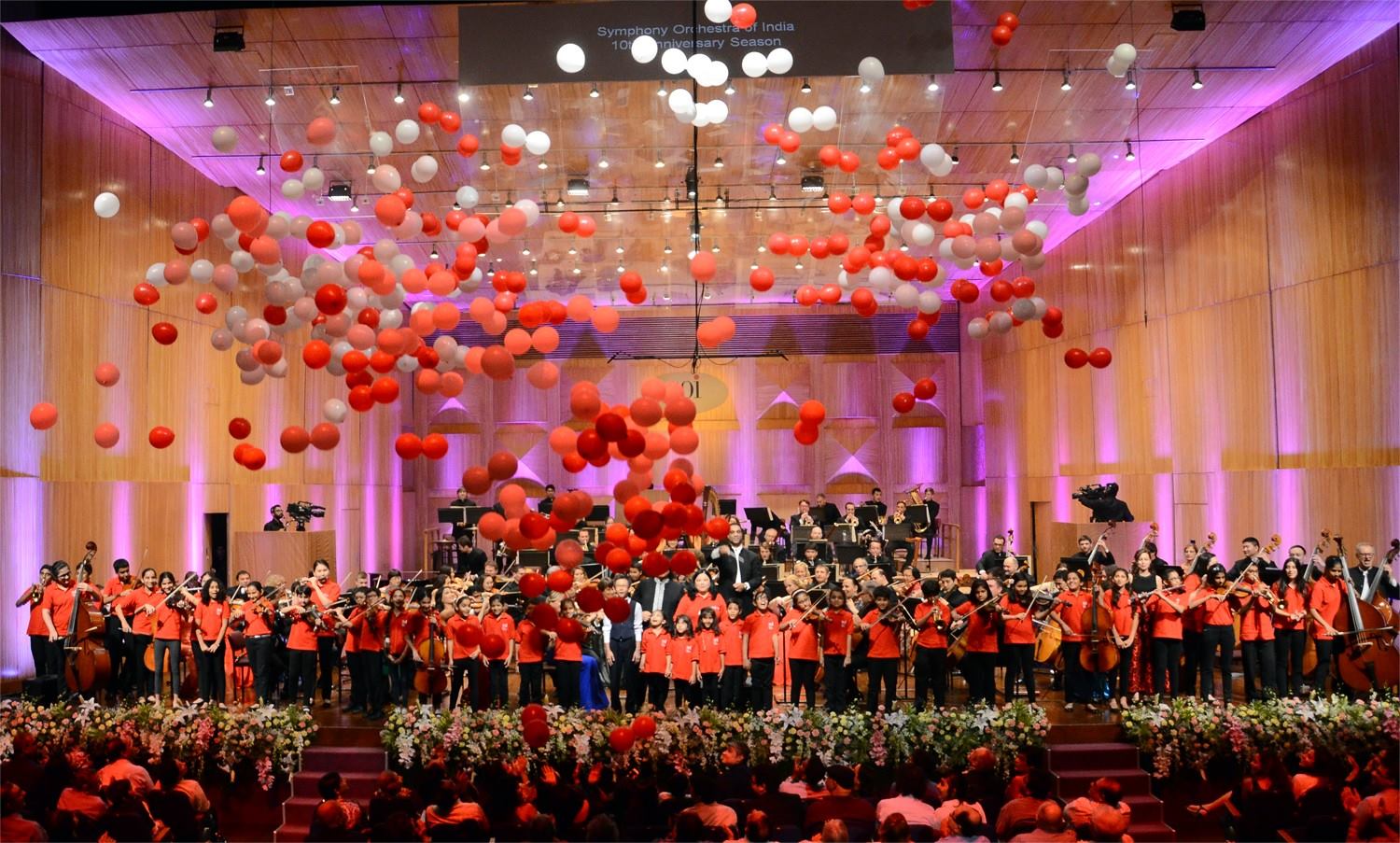
In September 2016, the Symphony Orchestra of India celebrated its 10th anniversary. To commemorate this milestone, the SOI presented a gala concert featuring light classical music including popular waltzes and overtures. The SOI’s Music Director Marat Bisengaliev and Associate Music Director Zane Dalal jointly led the concert. The festive evening culminated with the students of the SOI Music Academy joining the SOI to perform ‘Happy Birthday’ for the orchestra, as balloons rained down on a delighted audience.

In September 2016, the Symphony Orchestra of India celebrated its 10th anniversary. To commemorate this milestone, the SOI presented a gala concert featuring light classical music including popular waltzes and overtures. The SOI’s Music Director Marat Bisengaliev and Associate Music Director Zane Dalal jointly led the concert. The festive evening culminated with the students of the SOI Music Academy joining the SOI to perform ‘Happy Birthday’ for the orchestra, as balloons rained down on a delighted audience.